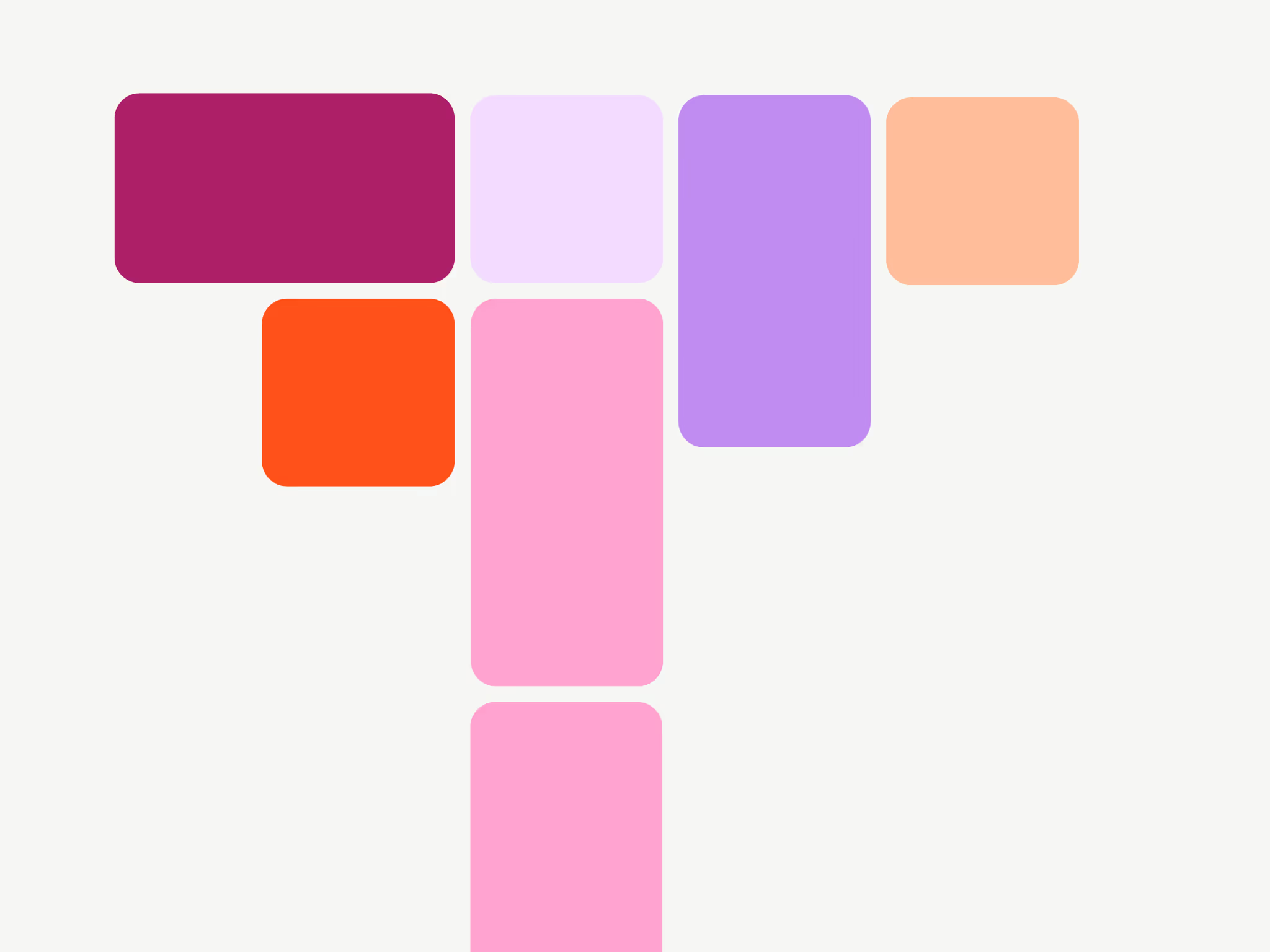Expanding into a new market is equal parts exciting… and challenging. Logistics, distribution, brand awareness, trust, adapting to cultural differences – these are all simply par for the course.
As an influencer marketer, you’re likely wondering how your work fits into this puzzle…
- Should you collaborate with creators when testing the waters in a new market? Or should you only bring on influencers when you’ve established a strong foothold in the new region/cohort?
- In the beginning, should you use influencer marketing solely for brand awareness, or to bring in sales?
- How do you even find the right influencers in a new market? Should you adapt your messaging, briefs, and workflows?
If you don’t know where to begin, I’ve got you. In this article, learn from 35 pros about how they power new market launches through influencer marketing.
3 Types of market expansion
Before we get into the practical tips, it’s worth highlighting that “market expansion” can mean one of three things:
- Launching in a new cohort of customers. Maybe your primary target was women, and now you’re launching products for men. In this case, you’re expanding your market in a new audience segment.
- Launching in a new area in your own country. It also counts as expansion when you stretch the limits of your geographical marketing zone to include other areas in your own country – sometimes, that means going from local to national.
- Launching in a new country. International market expansion is the biggest beast of them all. It requires you to immerse yourself in another culture and understand that country’s laws, buying power, logistics, etc.
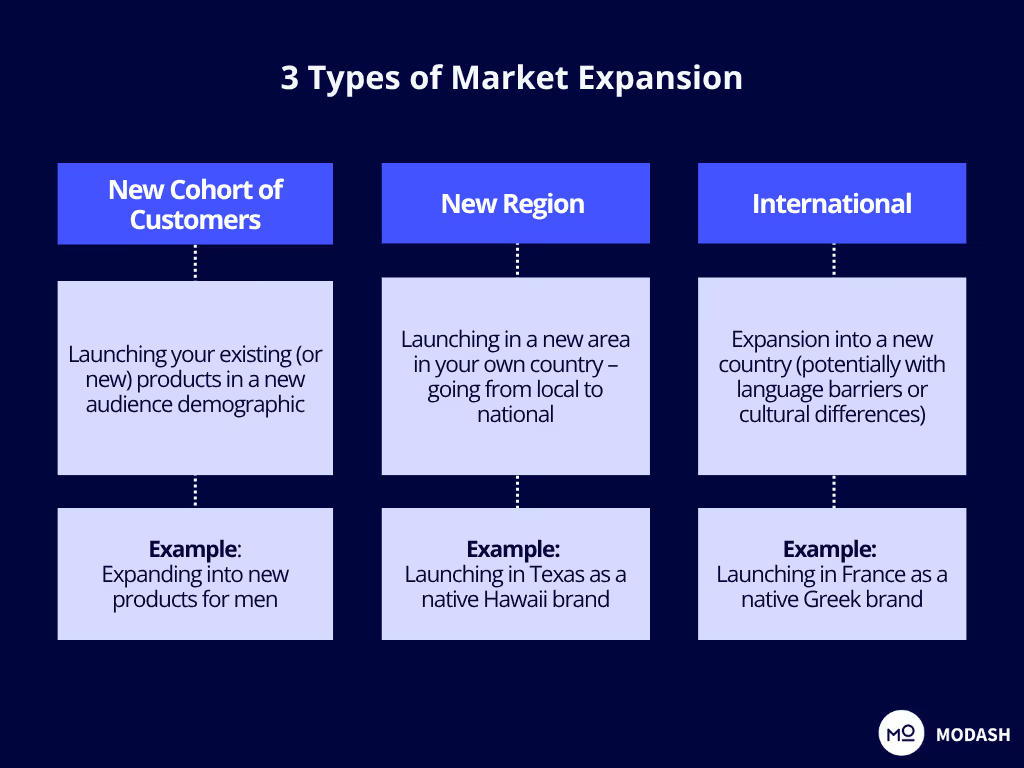
The scale of your market expansion impacts everything: at what stage you start influencer marketing, how much you collaborate with other departments in your company, and how you distribute your budget.
In our survey, 51% of participants had experience with international expansion, 34% had expanded into a new region in their own country, and 26% had so far expanded into a new cohort of customers.
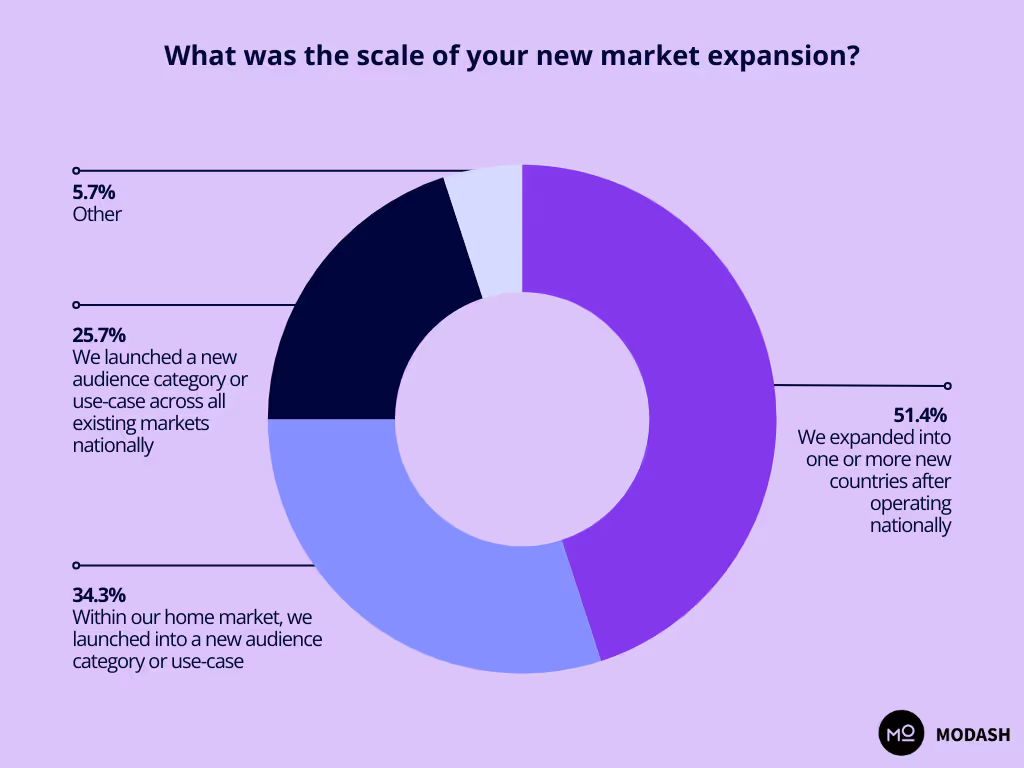
International expansion is hardest of all, requiring the most preparation. Not only do you need to understand the logistics and laws of a new country, but also the culture, language, and buyer choices.
The difficulty of expanding domestically depends on a country’s size, differences in consumer preferences and buying power from region to region, and laws. The US, for instance, has state-specific laws for businesses in addition to federal regulations. In many other countries, though, expanding nationally doesn’t require a lot of extra effort.
If you’re adding a new cohort of customers where you’re already present, you might not need to overhaul your logistics. But you might need to adjust your marketing around the expectations, values, and social media preferences of your new audience.
That said, the “difficulty level” of your market expansion is not set in stone – much is context-dependent. For instance, it might be easier to expand from Austria to Germany than it is to expand from a men-centric product to a women-centric one. It depends on the complexity of your product and the area/segment you’re expanding into (and how different it is from your current market).
As you read this article, adapt the advice to fit your scale of expansion.
Start by identifying a new market expansion opportunity
The next market opportunity is individual to each business. In our survey, a majority of marketers said they identified a new opportunity because they noticed one of the following:
- an uptick in the number of delivery requests in an area they weren’t present in
- a competitor’s success in a new market
- the presence of their target customers in a new market
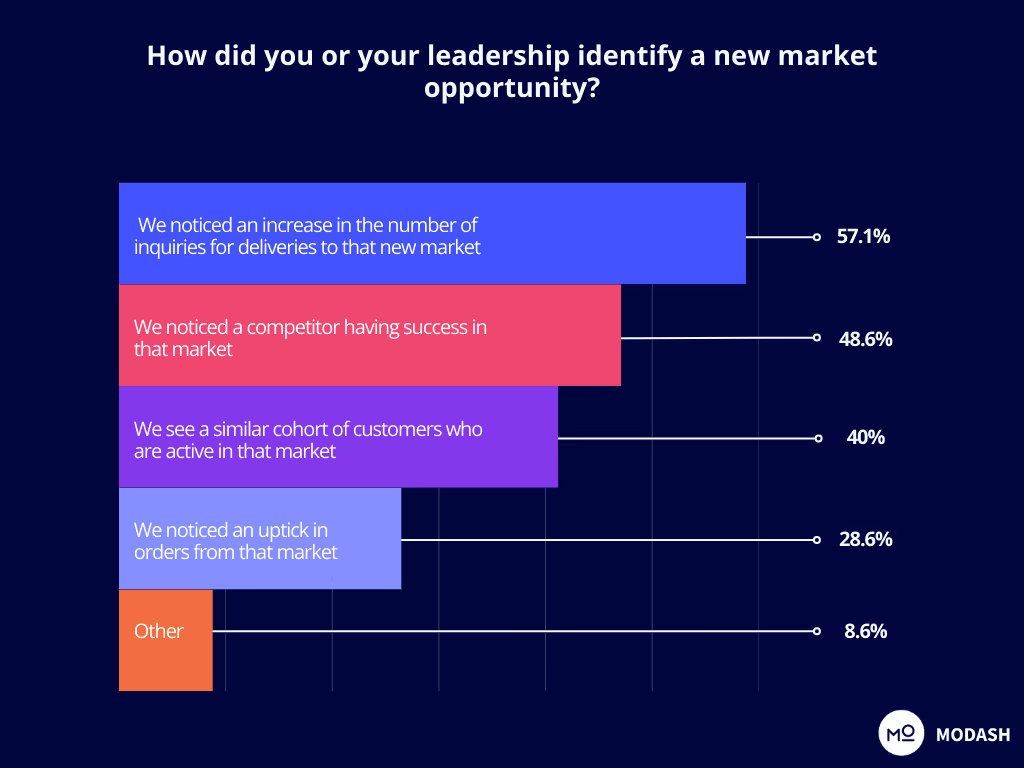
If you work with creators who have global influence, those partnerships can also help you find market expansion opportunities. Julianne Kiider shares how a YouTube influencer helped her make a case for entering a new market:
Aside from sales, you can also spot opportunities for new markets by monitoring comments, clicks, and website traffic coming via your influencer partners.
- Are you suddenly getting inquiries from a new demographic?
- Are comments on influencers’ posts asking whether or not your product ships to their location?
- Are you getting multiple website visitors or code redemptions from your influencers’ audience in a new country/market?
All of the above are telltale signs that your brand might be wanted in a new territory. You can validate these signs with data to make a stronger case to your leadership team. Remember, influencer marketing doesn’t work in a silo: it’s best practice to ask adjacent marketing and sales teams if they get inquiries from the same market you’ve spotted an opportunity in. If they do, it’s another point you can present in your favor to C-suite executives.
Victor Wiśniowski even suggests using influencer gifting to validate whether or not your products have a market in a new region or cohort:
In the above scenario, you’re using creators to help you decide whether or not entering a new market is feasible. And it’s an excellent idea – influencers often have a solid sense of what will sell and what will be a dud for their audience. If you do this testing at scale like Victor, you can gather reliable data about your new market expansion.
That said, you’ll often enter a new market because another team identified an opportunity or because your CEO wants to. In those cases, you’ll find creators not to validate your market expansion, but rather to make it successful.
2 Ways influencer marketing fits into a new market launch
Which teams are involved in a new market launch depends on the scale of your expansion and how you’re using influencer marketing.
Here’s why scale matters: if you’re only adding a new customer segment, the market expansion can be carried out by your own team and the adjacent marketing department. But if you’re expanding internationally, you need to involve the whole company for sales, marketing, customer service, shipping logistics, legal issues, and more.
There are two ways to use influencer marketing in a new product launch:
- Top-down: your leaders/sales determine and decide on a new market expansion, and you use influencer marketing to build brand awareness and drive conversions.
- Bottom-up: you use influencer marketing to test whether or not there’s an opportunity present in a new market.
.avif)
Neither approach is “better” – it depends on your brand’s goals and workflows. For example, Rugile Paleviciute suggests having a paid ads strategy for mature markets (along with influencer marketing efforts):
Julianne’s approach, on the other hand, is to lead a creator-first strategy, using influencer marketing to understand whether or not it’s worth investing in a new market.
Which of the two approaches is most common? Our survey revealed a slight majority: 40% of marketers said they worked with other departments to launch into a new region, while 37% said they used influencer marketing as a testing channel first.
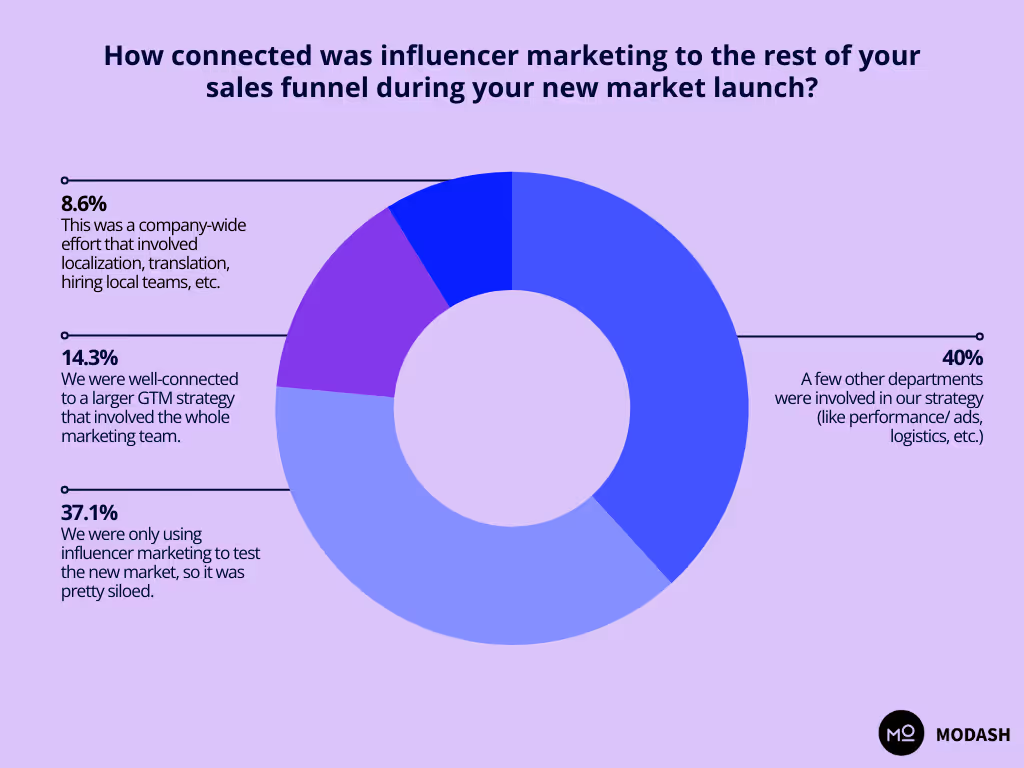
Which approach you take while implementing influencer marketing strategy in a new market largely depends on the maturity and budget of your brand.
If you’re a small company with a scrappy budget, influencer marketing is a smart way to test the waters in a new market with the bottom-up approach. Julianne agrees:
But if you can afford to put money into various marketing channels, run user interviews, and practice customer research, you can take the top-down approach and use influencer marketing after validating the market expansion.
How far ahead to start preparing a new market launch
Preparing for a new market launch requires you to figure out three things:
- How will you adapt your product catalog based on the market’s needs?
- How will you shift your brand messaging or marketing strategy?
- How will you find new influencers who fit your brand?
I’ll cover each of these in detail. But before I do, how far ahead should you start preparing? According to our survey, most marketers started planning their influencer marketing initiatives one to three months in advance.

How far ahead you should start planning depends on the scale of your expansion plus your team’s size and bandwidth. If you’re launching into a new country with significant cultural differences, you’ll likely need to prepare for more than three months. But if you’re expanding into a new but similar region within your own country, three months is probably enough lead time.
Your experience level also matters. If you’re an advanced player, you likely already have a rough time frame for entering a new market. If this is your first rodeo, give yourself more prep time than you think you need. In our survey, 46% of marketers said they have a go-to plan that they tweak based on the market.
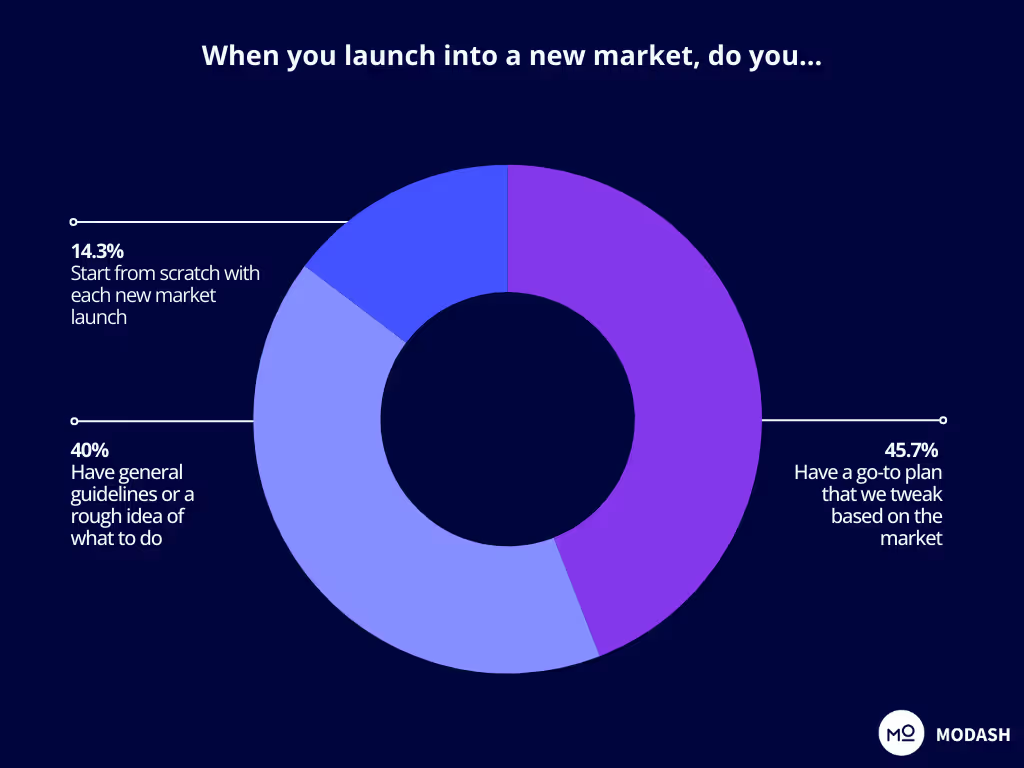
Now that you know how far ahead you should start preparing, let’s tackle each element of the new market launch.
How to adapt your product catalog for a new market
Over 45% of marketers in our survey said they adapted the products they’re promoting to fit the market they’re expanding to.
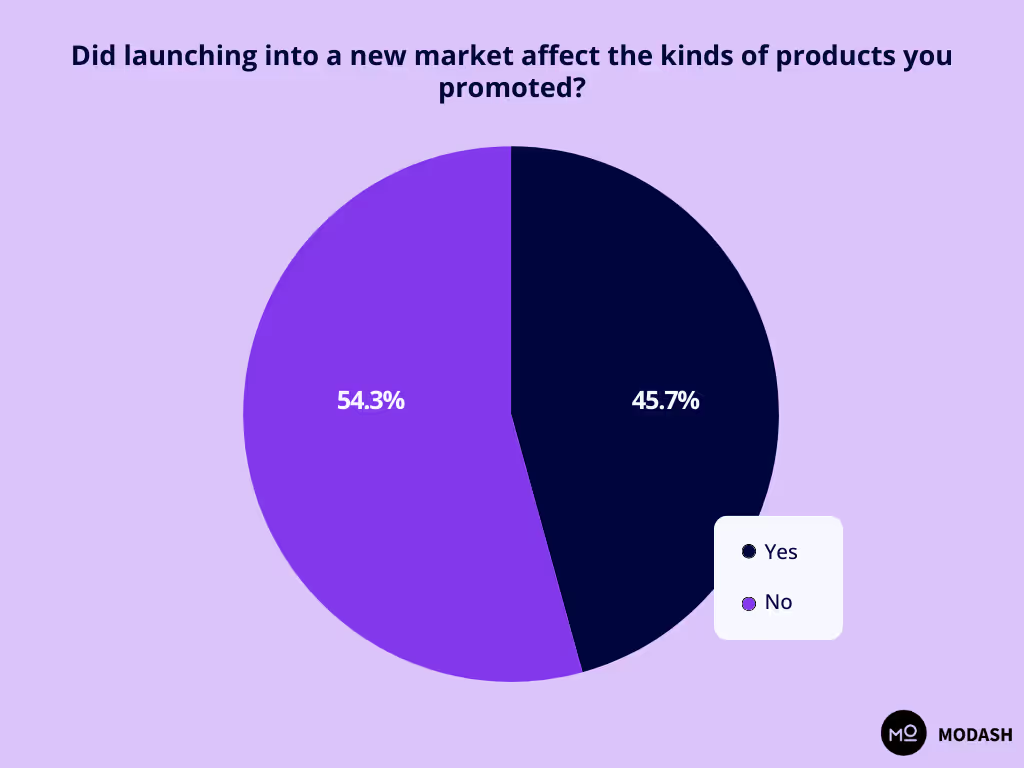
Why would you want to adjust your product catalog? There are various reasons. For Valerija Somi, it was because of a mix of buyer preferences, new market laws, and price range differences:
Greta Zacchetti also faced legal and logistical struggles, and had to reduce the number of products they could sell in a new market:
In some markets, established brands are already selling products similar to yours. It’d be tough to break into those markets and compete with them. Flora Macher faced this issue:
Another reason you might have to change the products you market is because of shipping costs. Michael Todner explains:
Apart from the logistical struggles, your product category also matters in a new market. If you’re launching a product no one has ever heard of, you need to do the upfront work of educating the customer first.
For example, Loop Earplugs are excellent for personal wellness. But Marit Tiesema, the brand’s Sr KOL & Ambassador Specialist, knows that this is an advanced use case for earplugs – most people just want them for sleeping. So, she begins by marketing the sleep earplugs and then gradually expands into the other types:
And lastly, it’s a good idea to tweak the products in your catalog because each market’s consumer preferences differ. Abdullah Khan agrees:
Getting local feedback and understanding buying habits is crucial. Rugile says she does a test run by marketing the company’s bestselling products via influencers. If they don’t get as much traction in the new market as hoped, she pivots into marketing other products that might work better based on the insight she gathered in the test run. She explains by giving an example of expanding into Japan:
The bottom line: conduct thorough local research of the market or cohort you’re expanding to and understand the laws, costs, competitors, and buyer preferences. Begin marketing the products that are legally in the clear and are most likely to sell.
How to shift your brand messaging and marketing strategy
The biggest hurdle when expanding into a new market – especially internationally – is that you don’t know the lingo of your target customers. Lee Drysdale explains why your messaging is important:
Over 65% of marketers in our survey said they adapt their brand messaging to fit a new market. But how?
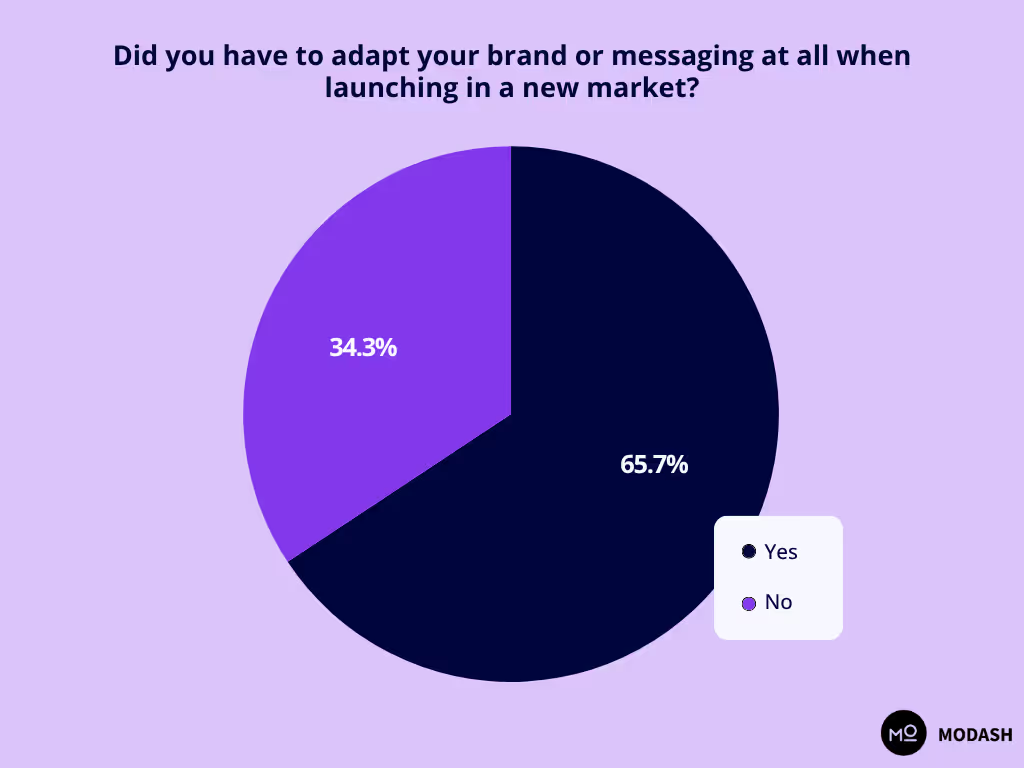
It may seem obvious, but language is foundational. If you’re expanding into a new international market, you’ll likely have to work in the market’s native language, which might not be your own. And this applies outside of influencer marketing – for example, you must have translations on your website to complete the funnel for your new market.
If you don’t speak the language of the market you’re expanding to, it’s best to partner with a local agency or freelancer to understand not just the language, but the culture as a whole. Lucy Sergeeva, for example, hires local copywriters:
The second common change to occur in brand messaging is the value prop. Different customers from varying markets would value different aspects of your product. You need to understand what the target market values and hone in on that (another reason why having someone local on your team is invaluable). Abdullah agrees:
Flora adds how she changed her messaging to fit the market:
Michael also tweaked the messaging of his products upon learning what the new market valued:
It’s also possible that different marketing channels or approaches attract attention in a new market in ways that aren’t common in your original market. Fernanda Marques explains with an example from Kanpai Foods:
She continues:
The key here is not only understanding what aspects of your product speak to your new target audience the most, but also how they make purchase decisions.
For example, Marit notes that in some markets, people make more impulse purchases, while in others, people might check for reviews and conduct thorough research before purchasing.
Knowing these subtleties will impact the kind of content you ask your influencers to create and how you design your influencer marketing funnel to drive more purchases and brand awareness.
Tweaking social media channels & content formats when expanding into a new market
Adapting your influencer marketing strategy also includes finding which content formats and social channels work better in a specific market. Joshita Dodani shares her experience:
Valerija also found that newer social media platforms had yet to catch on in some markets her company was trying to expand to. So, she stuck to the old-school channels:
Check the statistics on the most popular social networks per country (divided by user demographics) to get a rough idea of the best channels in any new market. Nacho Selma, for example, found that some social media platforms were more popular than others in certain markets:
Fernanda even moved to TikTok for a new market:
Rugile noticed that different kinds of posts got different results, depending on the market:
But Rugile always likes to practice YouTube influencer marketing in any new market for the benefits of long-form content:
How to find the right influencers in a new market
Finding the right influencers in a new market is the biggest challenge marketers face, followed by briefing and content tracking.
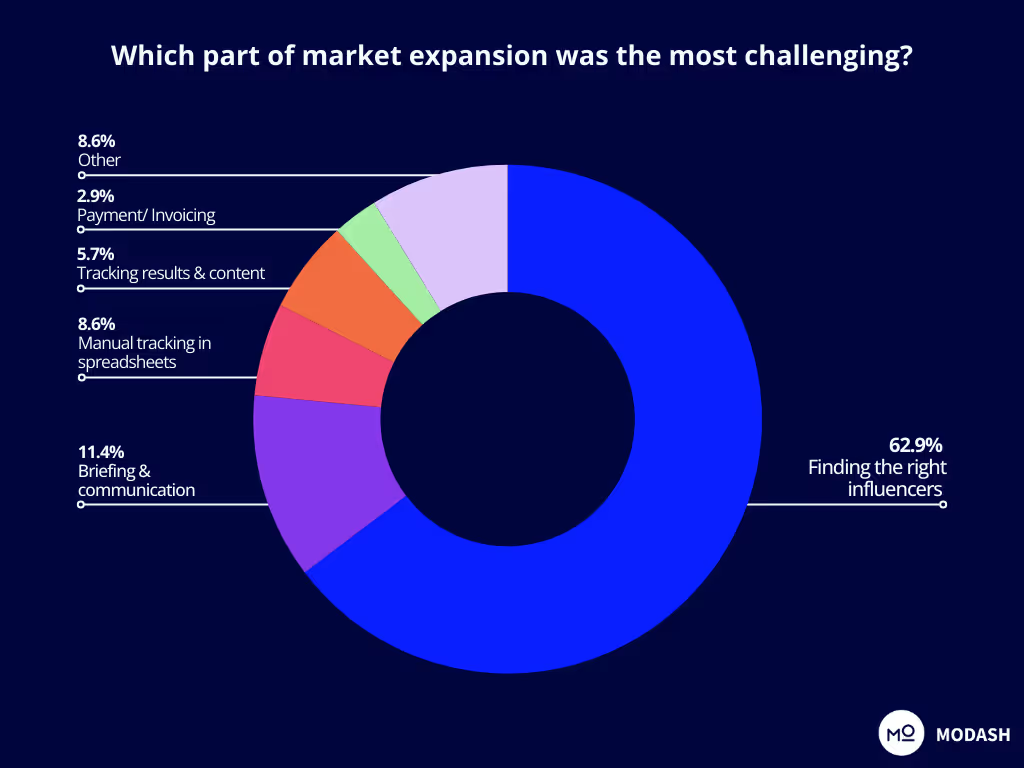
It’s not surprising: finding the right influencers is hard enough in your own region. In a new market, where you may not know the language, culture, or social norms, the task becomes exponentially more difficult. And still, it remains the most important.
So, how do you find the right influencers in a new market? Forty percent of marketers in our survey said they use a software.
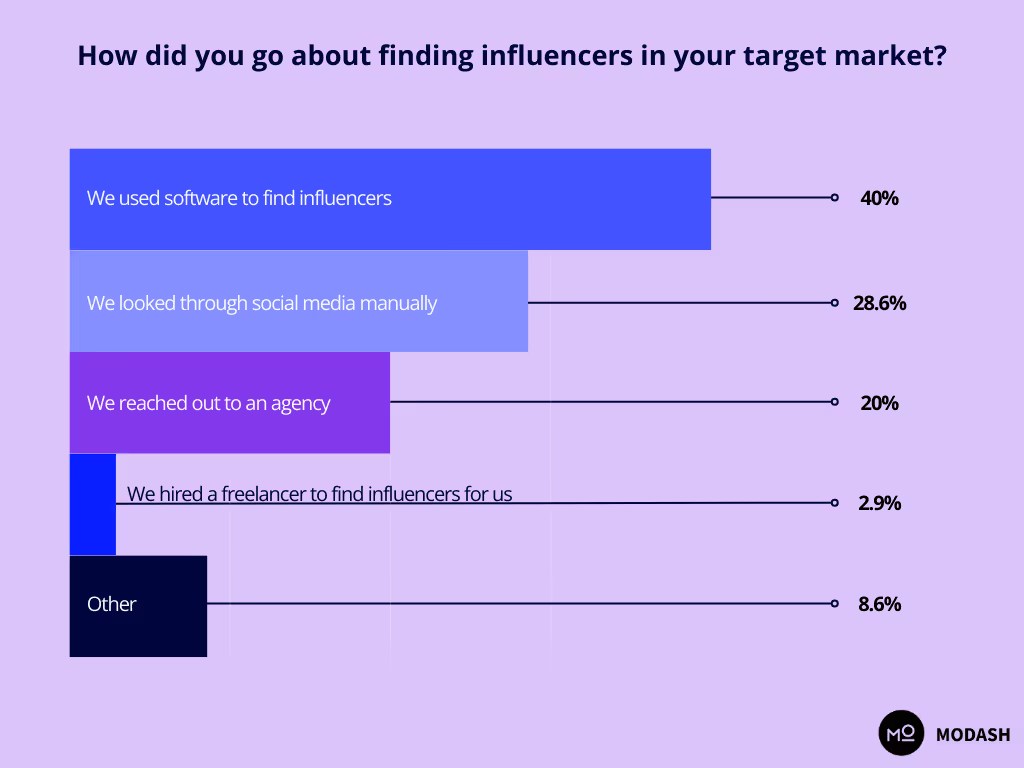
If you’re expanding into a new customer cohort within the same market, you’ll likely do just fine using an influencer marketing software. But if you’re launching in an entirely new and complex market where the culture, language, and customs are different, it’s better to seek local support in addition to the software search. A third party will validate your findings and might also introduce you to some hidden gems.
Rugile agrees that getting someone on the ground to help makes a huge difference:
She continues:
Julianne expands on how hiring a local agency can boost your influencer marketing efforts:
She continues:
Another benefit of partnering with someone local is that you can borrow their credibility to build trust with influencers and even improve your outreach response rates. Fernanda struggled with this in the initial stages of a new market expansion:
Now, if you’re outsourcing influencer discovery, should you go with an agency or a freelancer? Marit recommends choosing an agency if you’ve taken the top-down approach (i.e., you already know this market is ripe for expanding your brand) and you can afford it.
But if you’re using influencer marketing to test the waters in a new market, it’s better to hire a freelancer over an agency because of the expense:
Whichever route you choose, how should your vetting process – especially brand fit – evolve for the new market?
Brand fit: influencer vetting in new markets
When the markets are different, the influencers are, too. When vetting creators, you might not need to budge on your metric requirements like engagement rate, follower growth, etc., but you might need to adjust your “brand fit” requirements. Valerija elaborates:
It’s a delicate balance between keeping your overall brand perception intact while also tailoring influencer content to your customers in various markets. The best way to navigate this is by going back to the whiteboard – understanding consumer preferences and buying behavior.
In Japan, for example, influencers seldom show their face on camera. That might go against your brand requirements, but if it works better for a certain market, it’s worth giving your Japan-based influencers the creative freedom to make such content.
That said, don’t compromise on your brand values. No matter the market, your influencer partners should reflect your company’s values. If they don’t, they’re just not the right fit. Lucy agrees:
Julianne highlights that having control over the representation of your brand values is critical to maintaining your company’s reputation:
When evaluating influencers for brand fit, leave room for experimentation without shaking your foundation. Determine which aspects of your vetting criteria are non-negotiable and be open to adapting the rest.
Micro vs macro influencers in a new market
Is there a particular “size” of influencer to prioritize when entering a new market? Surprisingly, just over 54% of marketers in our survey said they don’t have one.
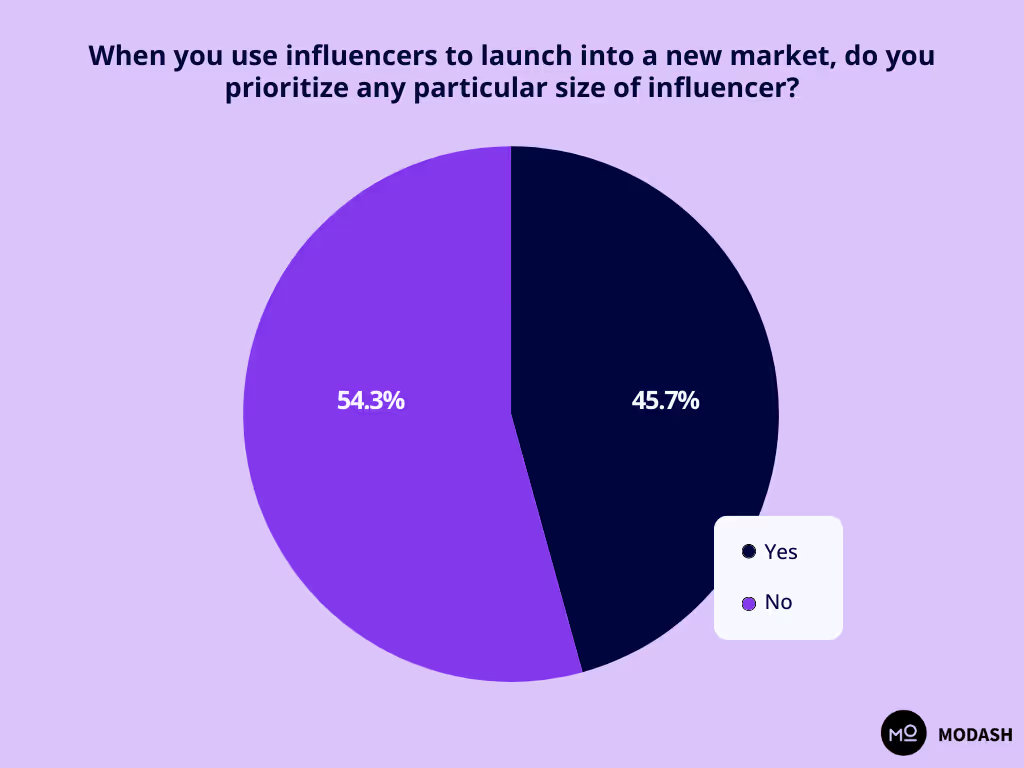
Your decision is primarily rooted in your budget, but let’s use a hypothetical example: if your budget allows hiring 2 big, popular influencers or 4–6 micro or nano creators, which option should you choose? Rugile suggests spreading your bets:
Victor’s approach – a combination of creators, big and small – is quite similar:
Micro influencers make sense when you’re on a tight budget or using influencer marketing as a testing environment for new market expansion. Senith Berhane agrees:
Abdullah also begins with small creators before adding bigger creators as the brand builds a more substantial presence in the new market:
Big influencers have their merit, though: they can help you reach a large number of people in your new market and drum up excitement about the launch. Plus, if you also get usage rights, you can make a better ROI by repurposing their influencer content for ads, like Lee does:
The verdict: choose a mix of small and big creators if you can afford to. If you can’t, stick to influential, local, micro creators with a decent engagement rate and authentic connection with their audience.
Should you start with brand awareness when expanding into a new market?
What should your campaign goals be when expanding into a new market? In our survey, 57% of marketers said they begin with brand awareness.
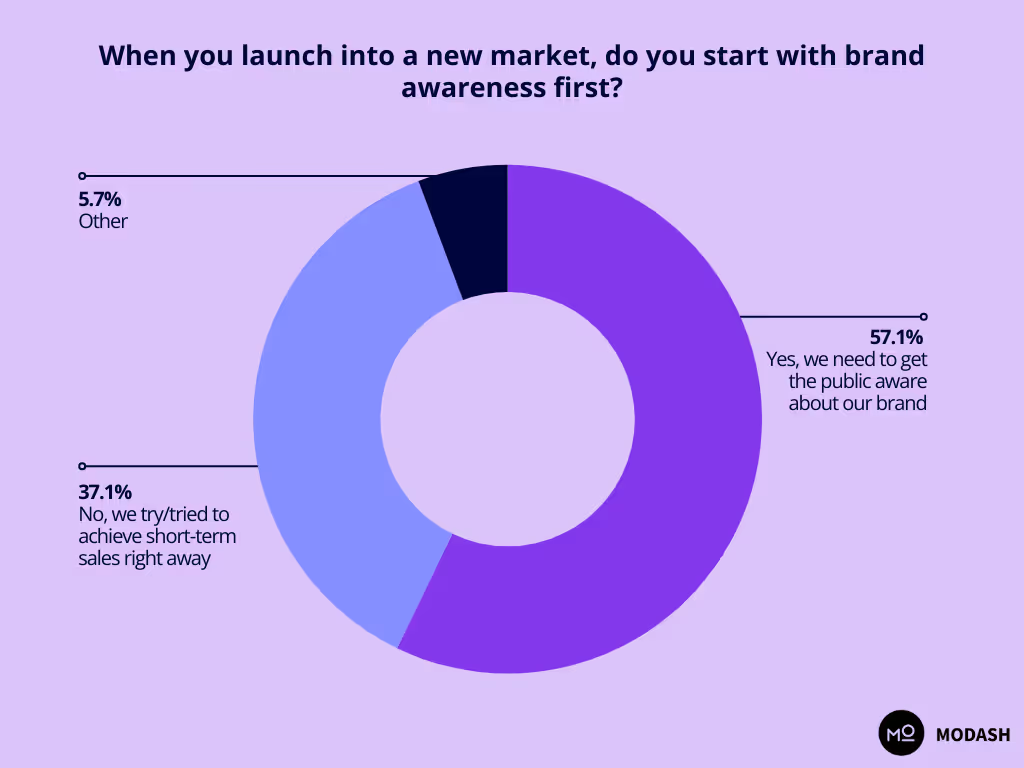
It makes sense: if you’re just entering a new market, first you need to make your potential buyers aware of their problem – and your product as the solution – before you encourage them to make a purchase.
But if you’re a small brand, you can’t always justify spending a large chunk of your budget on brand awareness, which often doesn’t have a direct ROI. What would you report to stakeholders? Greta can relate:
Not to worry – there are solutions. First, you could set a limit on the number of weeks or months you’ll aim for brand awareness only. For example, Fernanda’s ceiling was three months:
Another tactic is to run ads from brand awareness content, as Marit recommends:
You can also start slowly introducing performance-based incentives to your influencer collaborations after the initial brand awareness period has cooled off. This will motivate your influencer partners to drive conversions and make for a smoother transition.
3 Pro tips for acing your market expansion
Here are a few miscellaneous pro tips to keep in your back pocket as you launch into a new market:
1: Keep the full funnel in mind
You can have the best influencer content for a new market, but it won’t matter if your website isn't tailored for the locals, if your shipping costs break the bank, or if your brand has no presence beyond influencer marketing.
For your influencer marketing efforts to be successful, you must think of your brand and company as a whole.
Rugile, for example, leverages popular local review sites so her brand is perceived as legit in a new market:
This is important even if you’re adding a new customer cohort in your own market: do you have targeted copy, an educational website, and customer reviews sharing how your product is perfect for them specifically? If not, consider adding those to reduce customer friction and build trust.
2: Design your content around the local calendar
Each new market has specific holidays, seasons, and festivities. You must ensure your influencer marketing efforts cater to these by offering seasonal discounts, creating holiday-themed content, etc. By highlighting local specificities, you’ll make potential buyers feel that your brand is more aware of and familiar with them.
Marit explains with an example of the seasonal differences in Australia:
Rugile runs seasonal campaigns in Japan:
Do some research on local holidays and events in your new market, and be open to ideas from influencers around themed content.
3: Value influencer and agency relationships
It should go without saying, but remember: influencer marketing is a relationship business. The happier you keep your creators and agency partners, the better your results.
Focus on solidifying your creator relationships in new markets, too. Put a face to the name by going the extra mile and getting on a video call with influencers. Go out of your way to learn their dog’s name and their birthday.
And don’t forget the team that supports your creators – keep agents and influencer managers happy, too. Marit says forgetting to cultivate influencer relationships in the frenzy of a new market expansion is a common mistake marketers make:
Crossing the border, one influencer at a time
Using influencer marketing to launch into a new market is complex. And intense. And overwhelming. But it’s also exciting. And satisfying. And game-changing.
To set yourself up for success, you need solid systems, tools, and workflows that help you scale without holding you back. At this point, having hundreds of different spreadsheets might not cut the mustard.
So, how do you scale without losing your mind? You use a complete influencer marketing tool like Modash – one that can help you:
- find influencers
- vet their profiles with a fine-tooth comb
- track your outreach efforts
- measure your performance
- and a lot more… all under one roof!
Modash has every influencer on Planet Earth with over 1K followers across Instagram, YouTube, and TikTok – whenever you cross the border, it will follow.
Sound too good to be true? Try it risk-free, no strings attached for 14 days. Sign up today and watch the magic unfold ✨




















